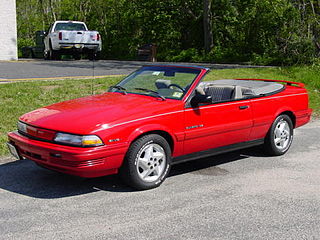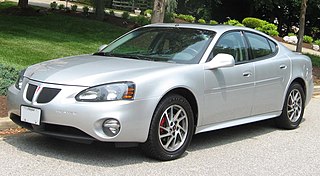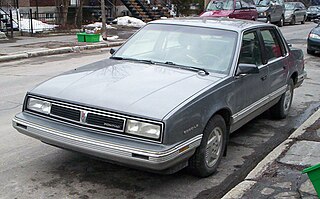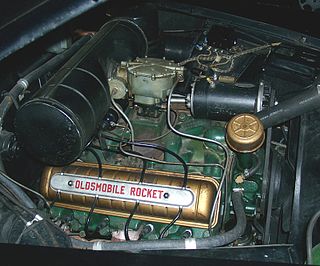
The Buick Skylark is a passenger car formerly produced by Buick. The model was made in six production runs, during 46 years, over which the car's design varied dramatically due to changing technology, tastes, and new standards implemented over the years. It was named for the species of bird called skylark.

The Pontiac Sunbird is a model line that was manufactured and marketed by Pontiac from the 1976 to the 1994 model years. Loosely deriving its name from the Pontiac Firebird, the Sunbird was introduced as the eventual replacement for the Pontiac Astre, replacing it entirely in 1978 as the smallest Pontiac.

The Oldsmobile Cutlass was a series of automobiles produced by General Motors' Oldsmobile division between 1961 and 1999. At its introduction, the Cutlass was Oldsmobile's entry-level model; it began as a unibody compact car, but saw its greatest success as a body-on-frame intermediate. The Cutlass was named after Vought F7U Cutlass, as well as the type of sword, which was common during the Age of Sail.

The Grand Prix is a line of automobiles produced by the Pontiac Division of General Motors from 1962 until 2002 for coupes and 1989–2008 for sedans.

The Pontiac Bonneville is an automobile built by Pontiac from 1957 until 2005. Bonnevilles were full-sized, with the exception of a brief period of mid-size between 1982 and 1986. The brand was introduced as a limited production performance convertible during the 1957 model year. The Bonneville, and its platform partner, the Grand Ville, are some of the largest Pontiacs ever built; in station wagon body styles they reached just over 230 inches (5.8 m) long, and at 5,000 pounds (2,300 kg) and more were also some of the heaviest cars produced at the time.

The Pontiac 6000 is a mid-size automobile manufactured and marketed by Pontiac for model years 1982 through 1991 in 2-door coupe, 4-door sedan and 5-door wagon body styles. The 6000 shared the front-wheel drive A platform with the Cutlass Ciera, Buick Century and Chevrolet Celebrity.

The Oldsmobile Cutlass Supreme is a mid-size car produced by Oldsmobile between 1966 and 1997. It was positioned as a premium offering at the top of the Cutlass range. It began as a trim package, developed its own roofline, and rose during the mid-1970s to become not only the most popular Oldsmobile but the highest selling model in its class.

Buick Century is the model name that was used by Buick for a line of upscale full-size cars from 1936 to 1942 and 1954 to 1958, as well as from 1973 to 2005 for mid-size cars.

The Buick Regal is a line of mid-size cars marketed by Buick since 1973. For nearly its entire production, the Regal has served as the premium mid-size/intermediate offering of the Buick product range. Introduced as a submodel of the Buick Century, the model line is currently in its sixth generation. From the 1970s to the 1990s, the Regal served as the Buick counterpart of the Pontiac Grand Prix and Oldsmobile Cutlass Supreme.

The Oldsmobile Starfire is an automobile nameplate used by Oldsmobile, produced in three non-contiguous generations beginning in 1954. The Starfire nameplate made its debut as a convertible concept car in 1953 followed with the 1954–1956 Ninety-Eight series convertibles that shared a "halo status" with the Buick Skylark and Cadillac Eldorado. For 1957 only, all Ninety-Eight series models were named "98 Starfire".

The General Motors 60° V6 engine family is a series of 60° V6 engines produced for both longitudinal and transverse applications. All of these engines are 12-valve cam-in-block or overhead valve engines, except for the LQ1 which uses 24 valves driven by dual overhead cams. These engines vary in displacement between 2.5 and 3.4 litres and have a cast-iron block and either cast-iron or aluminum heads. Production of these engines began in 1980 and ended in 2005 in the U.S., with production continued in China until 2010. This engine family was the basis for the GM High Value engine family. These engines have also been referred to as the X engines as they were first used in the X-body cars.

The Chevrolet Monza is a subcompact automobile produced by Chevrolet for the 1975 through 1980 model years. The Monza is based on the Chevrolet Vega, sharing its wheelbase, width, and standard inline-four engine. The car was designed to accommodate the GM-Wankel rotary engine, but due to mediocre fuel economy and emissions-compliance issues the engine was cancelled, and a V8 engine option was substituted. The Monza name has also been used for several other cars.

The Oldsmobile 4-4-2 is a muscle car produced by Oldsmobile between the 1964 and 1987 model years. Introduced as an option package for US-sold F-85 and Cutlass models, it became a model in its own right from 1968 to 1971, spawned the Hurst/Olds in 1968, then reverted to an option through the mid-1970s. The name was revived in the 1980s on the rear-wheel drive Cutlass Supreme and early 1990s as an option package for the new front-wheel drive Cutlass Calais.

The Buick V6 was an OHV V6 engine developed by the Buick division of General Motors and introduced in 1962. Originally 198 cu in (3.2 L) and initially marketed as Fireball, it later became popularly referred to as the 3800 for its various 3.8 L (230 cu in) incarnations.

The Oldsmobile V8, also referred to as the Rocket, is a series of engines that was produced by Oldsmobile from 1949 until 1990. The Rocket, along with the 1949 Cadillac V8, were the first post-war OHV crossflow cylinder head V8 engines produced by General Motors. Like all other GM divisions, Olds continued building its own V8 engine family for decades, adopting the corporate Chevrolet 350 small-block and Cadillac Northstar engine only in the 1990s. All Oldsmobile V8s were manufactured at plants in Lansing, Michigan while the engine block and cylinder heads were cast at Saginaw Metal Casting Operations.

Quad 4 is the name of a family of principally DOHC inline four-cylinder engines produced by General Motors' Oldsmobile division between 1987 and 2002; a single SOHC version was built between 1992 and 1994.

The Oldsmobile Cutlass Ciera is a mid-size car manufactured and marketed for model years 1982-1996 by the Oldsmobile Division of General Motors — over a single generation. Body styles included a 2-door coupe, 4-door sedan, and the 4-door wagon.

The Oldsmobile Calais is a compact car that was manufactured and marketed by Oldsmobile from 1985 through 1991, superseding the Oldsmobile Omega and named after the city of Calais, France. Renamed the Cutlass Calais for 1988, and briefly available in 1987 as the limited edition GMO Quad 4, the Calais shared the GM N platform with the Pontiac Grand Am and the Buick Skylark/Buick Somerset — and was superseded by the Oldsmobile Achieva in 1992.

The Pontiac Grand Am is a mid-size car and later a compact car that was produced by Pontiac. The Grand Am had two separate three-year runs in the 1970s: from 1973 to 1975, and again from 1978 to 1980. It was based on the GM A platform. Production of the intermediate sized Grand Am was canceled in 1980 when it was replaced by the Pontiac 6000. The compact-sized Grand Am was reintroduced in 1985 when it replaced the Pontiac Phoenix. It became Pontiac's best selling car and was later replaced by the Pontiac G6, so named as it was intended to be the 6th generation of the Grand Am.
The GM A platform was a rear wheel drive automobile platform designation used by General Motors from 1925 until 1959, and again from 1964 to 1981. In 1982, GM introduced a new front wheel drive A platform, and existing intermediate rear wheel drive products were redesignated as G-bodies.























